mcdil
Well-Known Member
Hello, everyone!
For those that aren't aware of Apex Outdoors, we are a Swiss lathe-turned, bullet manufacturer, headquartered in Texas, who began launching products earlier this summer. I thought I'd put a brief summary of Apex Outdoors and our bullet lines in one condensed post for quick reference.
Apex Outdoors
A company dedicated to providing best-in-class, patent pending, lead-free, bullets for the handloader and small ammunition provider for hunting and target shooting.
Afterburner Bullets
Our flagship bullet, designed to maximize performance across an immense range of parameters for a "no compromises", "no weaknesses" bullet. It's a low friction and fouling, ultra-high BC, petal shedding, mono-metal bullet with an incredibly impressive performance score card in EVERY category. It will correctly expand and shed petals in "tissue only" hits as low as 1650 fps, while providing maximum trauma and penetration on direct frontal hits into the brisket or skull of a charging brown bear at well over 3500 fps. Its ballistic coefficient for its weight is virtually unmatched, and it's one of the lowest friction bullets for minimal barrel fouling and wear coupled with higher starting muzzle velocities, accentuating its BC potential. We left nothing on the table with this bullet; it does it all.
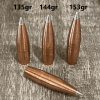
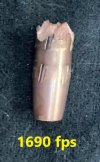
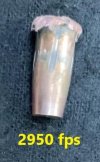
Haymaker Bullets
If our Afterburner is akin to the Corvette ZR1, the Haymaker is the Dodge Demon, raw and powerful. This bullet is all about absolutely maximizing terminal performance in the short to mid range operating window for the cartridges it's designed for. The Haymaker series is a more narrowed design scope. For instance, our first Haymaker, the 161gr 30 cal, is designed specifically for the 300 Blackout. No other cartridge criteria restricted the design, even though it will work well in some small 30 cal pistol platforms, like the 30-30. In the Blackout, whether a rifle or pistol platform, the 161gr Haymaker maximizes terminal performance at all ranges the Blackout would be shot at. It will open and fracture the front off at subsonic velocities and maintain that same exact terminal profile all the way to its maximum recommended impact velocity of 2400 fps, well above Blackout maximum velocities. As a midweight, it offers much improved trajectories over the heavyweights shot exclusively at subsonic velocities, and it hits harder than anything else in the Blackout. A 16" Blackout should yield roughly 1900 fps muzzle velocity near the upper end.
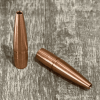
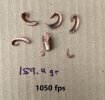
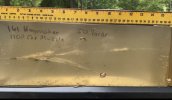
Target
While this particular line of bullets is self-explanatory, we incorporated our patent pending, low friction geometry to increase muzzle velocity and reduce friction and fouling. This feature, coupled with extremely high BCs in light weight designs, changes trajectory profiles, but more importantly significantly reduces time of flight for less overall error due to wind drift. Our currently released 30 cal 166gr easily attains 3200 fps in a 24" barreled 300 Win Mag, while maintaining a G7 BC of .293. Most other target bullets for 1:10" twist rifles that yield near that BC have nowhere near that muzzle velocity due to the fact that they're much heavier.
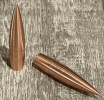
More information can be found on our website. I wanted to keep this post relatively brief. Feel free to ask any questions you may have. We are here to help! For those that have chosen to shoot Apex Outdoors bullets this hunting season, we thank you and wish you the best! Happy hunting!
For those that aren't aware of Apex Outdoors, we are a Swiss lathe-turned, bullet manufacturer, headquartered in Texas, who began launching products earlier this summer. I thought I'd put a brief summary of Apex Outdoors and our bullet lines in one condensed post for quick reference.
Apex Outdoors
A company dedicated to providing best-in-class, patent pending, lead-free, bullets for the handloader and small ammunition provider for hunting and target shooting.
Afterburner Bullets
Our flagship bullet, designed to maximize performance across an immense range of parameters for a "no compromises", "no weaknesses" bullet. It's a low friction and fouling, ultra-high BC, petal shedding, mono-metal bullet with an incredibly impressive performance score card in EVERY category. It will correctly expand and shed petals in "tissue only" hits as low as 1650 fps, while providing maximum trauma and penetration on direct frontal hits into the brisket or skull of a charging brown bear at well over 3500 fps. Its ballistic coefficient for its weight is virtually unmatched, and it's one of the lowest friction bullets for minimal barrel fouling and wear coupled with higher starting muzzle velocities, accentuating its BC potential. We left nothing on the table with this bullet; it does it all.



Haymaker Bullets
If our Afterburner is akin to the Corvette ZR1, the Haymaker is the Dodge Demon, raw and powerful. This bullet is all about absolutely maximizing terminal performance in the short to mid range operating window for the cartridges it's designed for. The Haymaker series is a more narrowed design scope. For instance, our first Haymaker, the 161gr 30 cal, is designed specifically for the 300 Blackout. No other cartridge criteria restricted the design, even though it will work well in some small 30 cal pistol platforms, like the 30-30. In the Blackout, whether a rifle or pistol platform, the 161gr Haymaker maximizes terminal performance at all ranges the Blackout would be shot at. It will open and fracture the front off at subsonic velocities and maintain that same exact terminal profile all the way to its maximum recommended impact velocity of 2400 fps, well above Blackout maximum velocities. As a midweight, it offers much improved trajectories over the heavyweights shot exclusively at subsonic velocities, and it hits harder than anything else in the Blackout. A 16" Blackout should yield roughly 1900 fps muzzle velocity near the upper end.



Target
While this particular line of bullets is self-explanatory, we incorporated our patent pending, low friction geometry to increase muzzle velocity and reduce friction and fouling. This feature, coupled with extremely high BCs in light weight designs, changes trajectory profiles, but more importantly significantly reduces time of flight for less overall error due to wind drift. Our currently released 30 cal 166gr easily attains 3200 fps in a 24" barreled 300 Win Mag, while maintaining a G7 BC of .293. Most other target bullets for 1:10" twist rifles that yield near that BC have nowhere near that muzzle velocity due to the fact that they're much heavier.

More information can be found on our website. I wanted to keep this post relatively brief. Feel free to ask any questions you may have. We are here to help! For those that have chosen to shoot Apex Outdoors bullets this hunting season, we thank you and wish you the best! Happy hunting!
